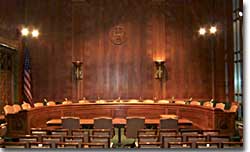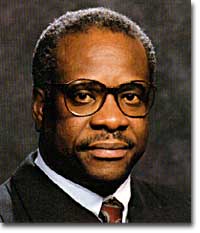9d. How Judges and Justices Are Chosen

The Senate Judiciary Committee reviews the president's nominees to the federal bench before they are confirmed on the Senate floor. The committee holds its meetings in rooms such as this one, Committee Room 226 in the Senate Dirksen Office Building.
Legendary Justice Oliver Wendell Holmes once said that a Supreme Court Justice should be a "combination of Justinian, Jesus Christ, and John Marshall."
Why are venerable former justices sources of guidance in understanding necessary qualities for federal judges?
The Constitution is silent on judicial qualifications. It meticulously outlines qualifications for the House of Representatives, the Senate, and the presidency, but it does not give any advice for judicial appointments other than stating that justices should exhibit "good behavior." As a result, selections are governed primarily by tradition.
The Nomination Process
The Constitution provides broad parameters for the judicial nomination process. It gives the responsibility for nominating federal judges and justices to the president. It also requires nominations to be confirmed by the Senate. First, look at the numbers.
More than 600 judges sit on district courts, almost 200 judges sit on courts of appeals, and 9 justices make up the Supreme Court. Because all federal judges have life terms, no single president will make all of these appointments.
But many vacancies do occur during a president's term of office. Appointing judges, then, could be a full-time job. A president relies on many sources to recommend appropriate nominees for judicial posts.
Recommendations often come from the Department of Justice, the Federal Bureau of Investigation, members of Congress, sitting judges and justices, and the American Bar Association. Some judicial hopefuls even nominate themselves.
A special, very powerful tradition for recommending district judges is called senatorial courtesy. According to this practice, the senators from the state in which the vacancy occurs actually make the decision. A senator of the same political party as the President sends a nomination to the president, who almost always follows the recommendation. To ignore it would be a great affront to the senator, as well as an invitation for conflict between the president and the Senate.
Selection Criteria

Supreme Court Justice Clarence Thomas was nominated to fill the position vacated by Thurgood Marshall. He served on the U.S. Court of Appeals before his nomination to the Supreme Court by George Bush.
Presidents must consider many factors in making their choices for federal judgeships:
- Experience — Most nominees have had substantial judicial or governmental experience, either on the state or federal level. Many have law degrees or some other form of higher education.
- Political ideology — Presidents usually appoint judges who seem to have a similar political ideology to their own. In other words, a president with a liberal ideology will usually appoint liberals to the courts. Likewise, conservative presidents tend to appoint conservatives.
- Party and personal loyalties — A remarkably high percentage of a resident's appointees belong to the president's political party. Although political favoritism is less common today than it was a few decades ago, presidents still appoint friends and loyal supporters to federal judgeships.
- Ethnicity and gender — Until relatively recently, almost all federal judges were white males. Today, however, ethnicity and gender are important criteria for appointing judges. In 1967, Lyndon Johnson appointed the first African American Supreme Court justice, Thurgood Marshall. In 1981, Ronald Reagan appointed the first woman to the Supreme Court, Sandra Day O'Connor. All recent presidents have appointed African Americans, Latinos, members of other ethnic minority groups, and women to district courts and courts of appeal.
Because federal judges and Supreme Court justices serve for life, a president's nomination decisions are in many ways his or her most important legacy. Many of these appointments will serve long after a president's term of office ends. Whether or not the results are a "combination of Justinian, Jesus Christ, and John Marshall," these choices can have an impact on generations to come.








